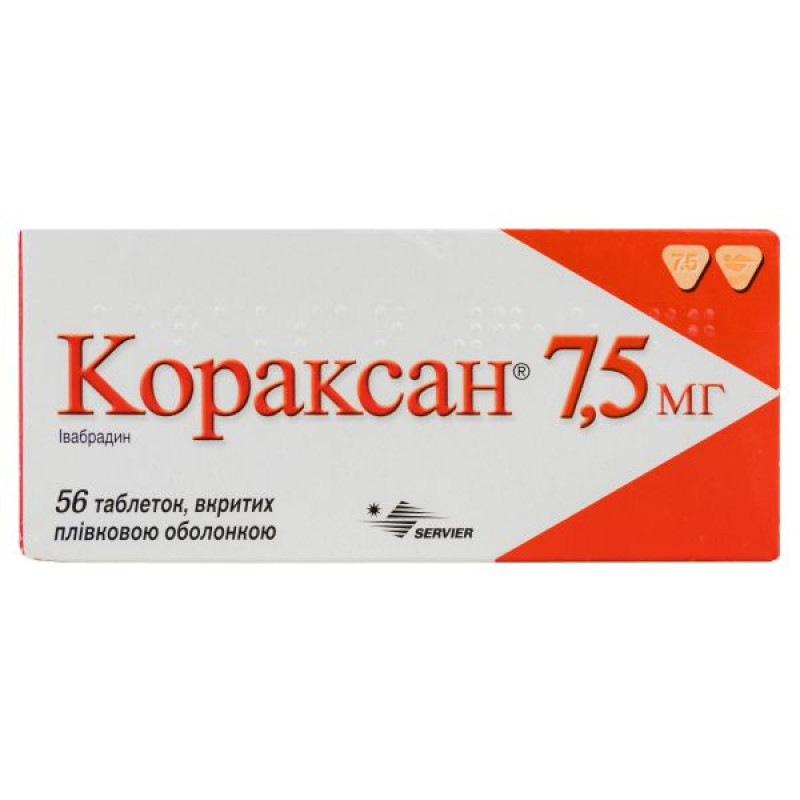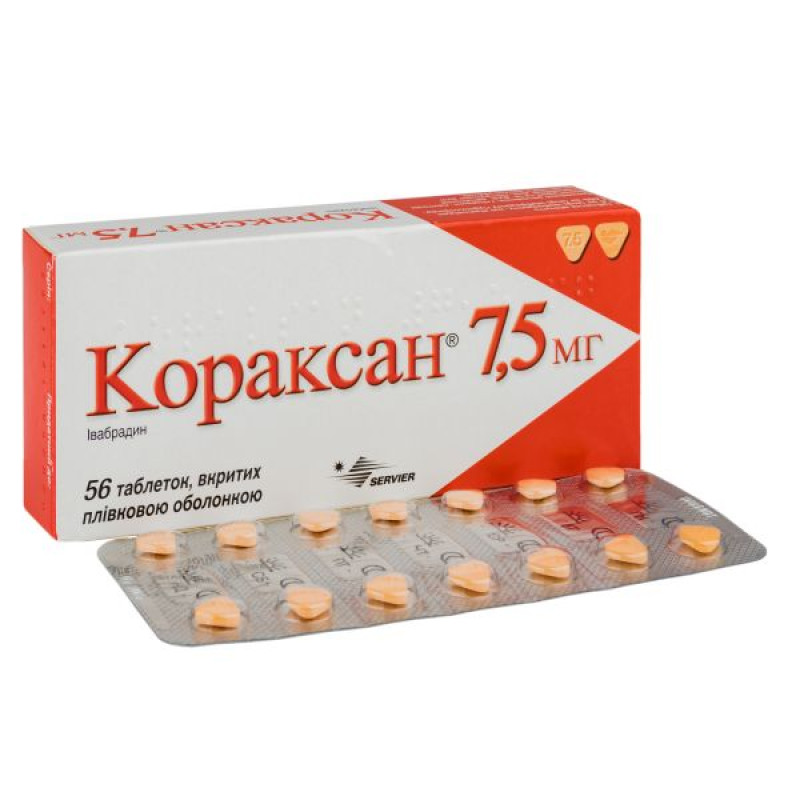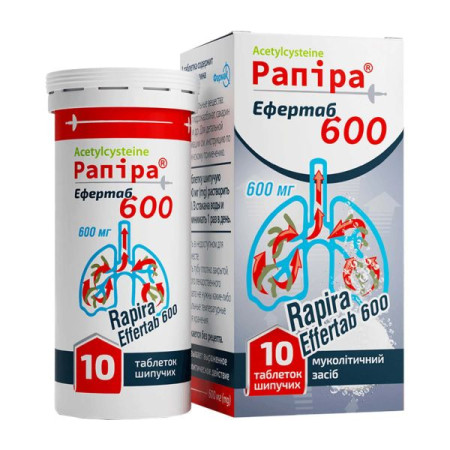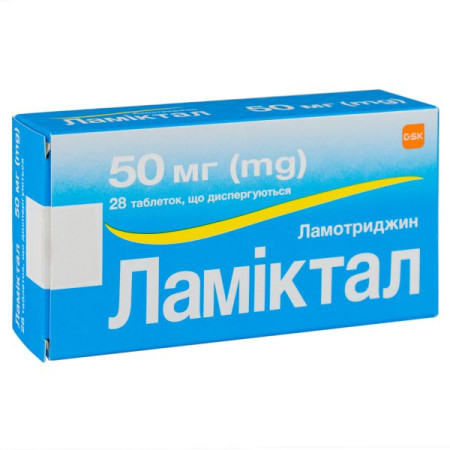Coraxan 7.5 mg film-coated tablets 7.5 mg No. 56
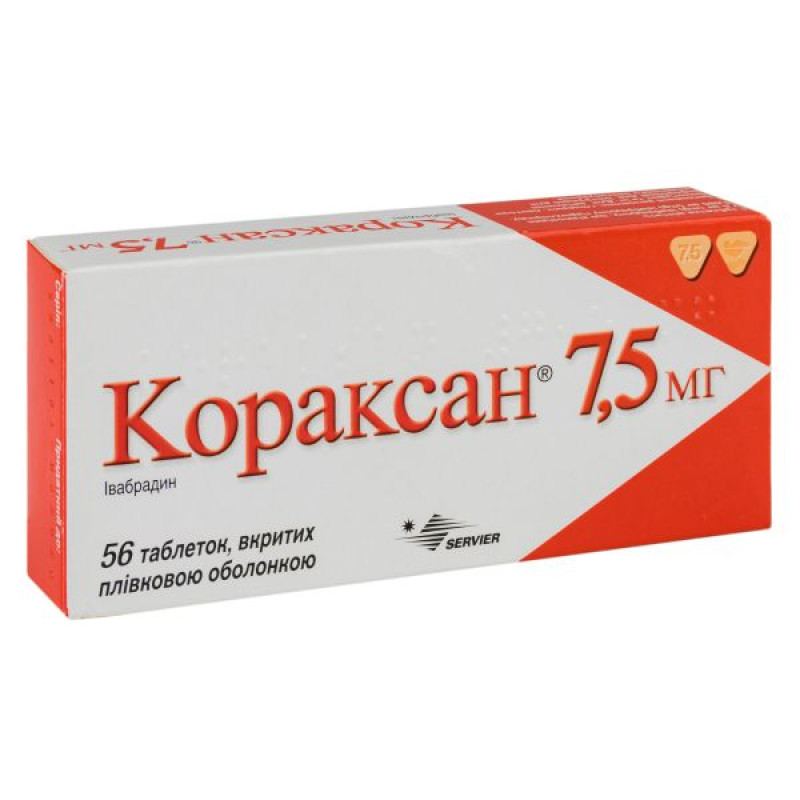
Instructions for use Coraxan 7.5 mg film-coated tablets 7.5 mg No. 56
Composition
active ingredient: ivabradine;
1 tablet contains 5 mg of ivabradine, corresponding to 5.39 mg of ivabradine hydrochloride, or 7.5 mg of ivabradine, corresponding to 8.085 mg of ivabradine hydrochloride;
excipients: lactose monohydrate, magnesium stearate, corn starch, maltodextrin, colloidal anhydrous silicon dioxide;
film coating: glycerol, hypromellose, iron oxide yellow (E 172), iron oxide red (E 172), macrogol 6000, magnesium stearate, titanium dioxide (E 171).
Dosage form
Film-coated tablets.
Main physicochemical properties:
Coraxan® 5 mg: an oblong tablet, coated with an orange-pink film coating, with notches on both edges and embossed with "5" on one side and "" on the other.
Coraxan® 7.5 mg: triangular-shaped tablet, coated with an orange-pink film coating, embossed with “7.5” on one side and “” on the other.
Pharmacotherapeutic group
Cardiological drugs. Other cardiological drugs. ATX code C01E B17.
Pharmacological properties
Pharmacodynamics.
Mechanism of action.
Ivabradine is a substance that exclusively reduces heart rate (HR) by acting on the cardiac pacemaker by selective and specific inhibition of the If current, which controls spontaneous diastolic depolarization at the level of the sinus node, regulating heart rate. Ivabradine acts exclusively on the sinus node and does not affect intraatrial, atrioventricular and intraventricular conduction, myocardial contractility and ventricular repolarization.
Ivabradine may also interact with the retinal Ih current, which is structurally similar to the If current of the sinus node. This is the basis for the development of a temporary impairment of photoperception due to a decrease in the retinal response to bright light stimuli. When triggering circumstances occur (sudden changes in lighting), partial inhibition of the Ih current by ivabradine may lead to the unexpected occurrence of visual phenomena in patients. Visual phenomena (phosphenes) are described as a temporary increase in brightness in a limited area of the visual field (see section "Adverse reactions").
Pharmacodynamic effects.
The main pharmacodynamic property of ivabradine is a selective dose-dependent reduction in heart rate. Analysis of heart rate reduction with ivabradine at doses < 20 mg twice daily showed a tendency towards a plateau effect, which reduces the risk of severe bradycardia < 40 bpm (see section 4.8).
When ivabradine is used at recommended therapeutic doses (5-7.5 mg twice daily), the heart rate decreases by approximately 10 beats/min at rest and during exercise. This reduces cardiac work and myocardial oxygen consumption. Ivabradine does not affect intracardiac conduction, myocardial contractility (no negative inotropic effect) and ventricular repolarization:
In clinical electrophysiological studies, ivabradine did not affect atrioventricular or intraventricular conduction or the corrected QT interval;
In patients with left ventricular dysfunction (left ventricular ejection fraction [LVEF] 30–45%), ivabradine did not show any negative effect on LVEF.
Clinical efficacy and safety.
The antianginal and antiischemic efficacy of ivabradine was demonstrated in five double-blind, randomized trials (three versus placebo and one each versus atenolol and amlodipine). These trials included 4111 patients with chronic stable angina, 2617 of whom received ivabradine.
Ivabradine 5 mg twice daily was shown to be effective in exercise stress tests after 3–4 weeks of treatment. Additional benefits of increasing the dose of ivabradine to 7.5 mg twice daily were demonstrated in a controlled comparative study with atenolol: the duration of the exercise stress test in the interdose period increased by 1 minute after one month of treatment with ivabradine 5 mg twice daily; three months after increasing the dose to 7.5 mg twice daily, a further increase of almost 25 seconds was observed. In this study, the antianginal and antiischemic properties of ivabradine were confirmed in patients ≥ 65 years of age. The efficacy of ivabradine at doses of 5 and 7.5 mg twice daily was consistent across all studies in terms of exercise testing (total duration of exercise, time to onset of limiting angina, time to angina attack, time to 1 mm ST segment depression) and was accompanied by a reduction in the number of angina attacks of approximately 70%. The twice daily dosing regimen of ivabradine provided a stable efficacy over 24 hours.
Studies have shown that the efficacy of ivabradine is fully maintained over 3–4 months of treatment. No pharmacological tolerance (loss of efficacy) or withdrawal effects were observed in these studies after abrupt discontinuation of treatment. The antianginal and antiischemic efficacy of ivabradine was associated with a dose-dependent reduction in heart rate and a significant reduction in the double product (DP), which reflects myocardial oxygen demand, at rest and during exercise (DP = HR × systolic blood pressure [SBP]). The effect of ivabradine on blood pressure (BP) and peripheral vascular resistance was minimal and of no clinical significance.
A 1-year study in 713 patients confirmed the sustained effect of ivabradine on heart rate reduction and demonstrated the absence of effects of ivabradine on glucose and lipid metabolism.
The anti-ischemic and antianginal efficacy and safety of ivabradine were confirmed in patients with diabetes mellitus (n = 457).
In the large-scale BEAUTIFUL study of morbidity and mortality in 10,917 people with coronary heart disease and left ventricular dysfunction (LVEF < 40%), ivabradine was administered on the background of optimal background therapy (86.9% of patients received β-blockers). The main criterion of efficacy (primary composite endpoint) was the total number of cardiovascular death, hospitalization for myocardial infarction (MI), and for the development or worsening of heart failure (HF). The study showed no significant difference in the reduction of the primary composite endpoint between the ivabradine and placebo groups both in the overall population (relative risk [RR] 1.00; p = 0.94) and in the analysis of the subgroup of patients with heart rate ≥ 70 beats / min (RR 0.91; p = 0.17). However, in the group of patients with heart rate ≥ 70 beats/min who took ivabradine, the incidence of hospitalizations for fatal and nonfatal MI decreased by 36% (p = 0.001), and coronary revascularization by 30% (p = 0.016).
A subanalysis of the subgroup of patients with symptomatic angina (n = 1507) showed that the primary endpoint was reduced by 24% in the ivabradine group (p = 0.05). This advantage was mainly due to a significant reduction in hospitalizations for MI (42%; p = 0.021). The reduction in hospitalizations for fatal and non-fatal MI was even more significant (73%; p = 0.002) in the group of patients with limiting angina and a heart rate ≥ 70 beats/min.
In the large SIGNIFY morbidity and mortality study in 19,102 patients with coronary heart disease without clinical evidence of heart failure (LVEF > 40%), ivabradine was administered on top of optimal background therapy. This study used a higher than approved dose regimen (starting dose of 7.5 mg twice daily [5 mg twice daily for patients over 75 years of age] and titration to 10 mg twice daily). The primary efficacy endpoint was the composite primary endpoint, which was the total number of cardiovascular death or non-fatal myocardial infarction. The study did not show a difference in the incidence of the composite primary endpoint between the ivabradine and placebo groups (HR 1.08; p = 0.197). Bradycardia was observed in 17.9% of patients in the ivabradine group (2.1% in the placebo group). During the study, 7.1% of patients were receiving verapamil, diltiazem or strong CYP3A4 inhibitors.
A small statistically significant increase in the incidence of the composite primary endpoint was observed in a prespecified subgroup of patients with Canadian Cardiovascular Society (CCS) class II or higher angina (n = 12,049) (3.4% events per year vs. 2.9%, HR 1.18; p = 0.018); but no such effect was observed in the subgroup of the general population with CCS class ≥ I angina (n = 14,286) (HR 1.11; p = 0.110).
The use of a higher than approved dose in the study partly explains the results obtained.
SHIFT is a multicenter, international, randomized, double-blind, placebo-controlled, morbidity and mortality study that included 6,505 adult patients with stable chronic heart failure (CHF) and left ventricular dysfunction (LVEF ≤ 35%). The study included patients with systolic CHF functional classes II–IV (according to the New York Heart Association [NYHA] classification of chronic heart failure) of ≥ 4 weeks duration and a resting heart rate ≥ 70 beats/min.
This study demonstrated a clinically and statistically significant reduction in the combined primary endpoint (cardiovascular death and hospitalization for worsening HF) by 18% (HR 0.82, 95% confidence interval [CI] 0.75–0.90; p < 0.0001). The absolute reduction in HF was 4.2%. The effect of ivabradine treatment was evident as early as the first 3 months of therapy. The results of the combined primary endpoint were mainly driven by the endpoints of HF, hospitalization for worsening HF (absolute reduction in HF of 4.7%) and HF deaths (absolute reduction in HF of 1.1%).
Effect of ivabradine therapy on the combined primary endpoint, its components and secondary endpoints
| Ivabradine (N = 3241) n (%) | Placebo (N = 3264) n (%) | VR (95% CI) |
| |
| Combined primary endpoint | 793 (24.47) | 937 (28.71) | 0.82 (0.75–0.90) | < 0.0001 |
Components of the primary endpoint: death due to cardiovascular events; hospitalization for worsening HF | 449 (13.85) 514 (15.86) | 491 (15.04) 672 (20.59) | 0.91 (0.80–1.03) 0.74 (0.66–0.83) | 0.128 < 0.0001 |
Other secondary endpoints: death from any cause; death caused by HF; hospitalization for any reason; hospitalizations for cardiovascular disease | 503 (15.52) 113 (3.49) 1231 (37.98) 977 (30.15) | 552 (16.91) 151 (4.63) 1356 (41.54) 1122 (34.38) | 0.90 (0.80‒1.02) 0.74 (0.58‒0.94) 0.89 (0.82–0.96) 0.85 (0.78‒0.92) | 0.092 0.014 0.003 0.0002 |
The reduction in the incidence of the combined primary endpoint was observed regardless of gender, NYHA class, ischemic or non-ischemic etiology of HF, and the presence of a comorbidity (diabetes mellitus or arterial hypertension) in the patient's history.
In the subgroup of patients with heart rate ≥ 75 bpm (n = 4150), there was a significant reduction in the primary endpoint by 24% (HR 0.76, 95% CI 0.68–0.85; p < 0.0001) and other secondary endpoints, including all-cause death (HR 0.83, 95% CI 0.72–0.96; p < 0.0109) and death due to cardiovascular events (HR 0.83, 95% CI 0.71–0.97; p < 0.0166). The safety profile of ivabradine in this subgroup of patients is consistent with that in the general population.
This study demonstrated a significant reduction in the incidence of the composite primary endpoint in the overall group of patients receiving β-blocker therapy (HR 0.85, 95% CI 0.76–0.94). In the subgroup of patients with heart rate ≥ 75 beats/min who received β-blockers at recommended doses, there was no statistically significant effect on the composite primary endpoint (HR 0.97, 95% CI 0.74–1.28) and other secondary endpoints, including hospitalization for worsening HF (HR 0.79, 95% CI 0.56–1.10) or death from HF (HR 0.69, 95% CI 0.31–1.53).
A significant improvement in functional class (according to NYHA classification) was observed in 887 (28%) patients in the ivabradine group compared with 776 (24%) patients in the placebo group (p = 0.001).
In a randomised placebo-controlled study involving 97 patients, data obtained during specific ophthalmological examinations aimed at documenting the function of the cone and rod systems and the ascending visual pathway (using electroretinogram analysis, static and kinetic visual fields, colour vision, visual acuity) in patients treated with ivabradine for the treatment of chronic stable angina for 3 years did not confirm any retinal toxicity.
Pharmacokinetics.
Under physiological conditions, ivabradine is rapidly released and has a high water solubility (> 10 mg/ml). Ivabradine is the S-enantiomer, which has not been shown to undergo bioconversion in vivo. The main active metabolite of ivabradine is the N-desmethylated derivative.
Absorption and bioavailability. After oral administration, ivabradine is rapidly and almost completely absorbed. When administered on an empty stomach, the maximum concentration (Cmax) in the blood plasma is reached after approximately 1 hour. The absolute bioavailability of ivabradine is approximately 40%, which is due to the effect of the first passage through the digestive tract and liver. Taking the drug simultaneously with food slows down absorption by approximately 1 hour and increases the plasma concentration by 20-30%. To avoid intraindividual fluctuations in the concentration of ivabradine in the blood plasma, it is recommended to take the drug with food (see section "Method of administration and dosage").
Biotransformation: Ivabradine is extensively metabolised in the liver and intestine by oxidation by the cytochrome P450 3A4 (CYP3A4) system. The main active metabolite of ivabradine is its N-desmethyl derivative (S18982), the concentration of which is 40% of that of ivabradine hydrochloride. The main active metabolite is also metabolised by the cytochrome CYP3A4 system. Ivabradine has a low affinity for CYP3A4, does not activate or inhibit it, and is therefore unlikely to alter CYP3A4 metabolism or its plasma concentration. However, inhibitors and inducers of CYP3A4 may significantly affect the plasma concentration of ivabradine (see section 4.5).
Elimination: The mean elimination half-life of ivabradine is 2 hours (70-75% of the area under the curve of the blood concentration-time curve [AUC]), the effective half-life is 11 hours. The total clearance of ivabradine is 400 ml/min, and the renal clearance of ivabradine is 70 ml/min. Metabolites are excreted equally in urine and feces. Approximately 4% of the active substance is excreted unchanged in urine.
Linearity/non-linearity: The kinetics of ivabradine for doses of 0.5–24 mg are linear.
Special patient groups.
Elderly patients (65-75 years): pharmacokinetic parameters (AUC and Cmax) in patients of this age group do not differ from pharmacokinetic parameters in the general patient population.
Renal impairment: The effect of renal impairment (creatinine clearance 15-60 ml/min) on the kinetics of ivabradine is minimal given the small proportion of renal clearance (approximately 20%) of the total clearance of ivabradine and its main metabolite S18982 (see section 4.2).
Hepatic impairment: In patients with mild hepatic impairment, the unbound AUC of ivabradine and the main active metabolite were 20% higher than in patients with normal hepatic function. There are limited data on the pharmacokinetics of ivabradine in patients with moderate hepatic impairment; no data are available in patients with severe hepatic impairment (see sections 4.2 and 4.3).
Pharmacokinetic/pharmacodynamic relationship. Analysis of the pharmacokinetic/pharmacodynamic relationship demonstrated a linear relationship between the reduction in heart rate and the increase in plasma concentrations of ivabradine and its active metabolite for doses of 15-20 mg twice daily. At higher doses, the reduction in heart rate becomes disproportionate to the plasma concentration of ivabradine and tends to reach a plateau. High plasma concentrations of ivabradine may be due to the use of ivabradine in combination with strong CYP3A4 inhibitors, which can lead to a significant reduction in heart rate, but the risk is reduced when ivabradine is used in combination with moderate CYP3A4 inhibitors (see sections “Contraindications”, “Special instructions” and “Interaction with other medicinal products and other forms of interaction”).
Indication
Symptomatic treatment of chronic stable angina.
Coraxan® is indicated for the symptomatic treatment of chronic stable angina in adult patients with coronary artery disease, normal sinus rhythm and heart rate ≥ 70 beats/min. The drug should be prescribed:
patients who have contraindications or restrictions to the use of β-blockers;
in combination with β-blockers in patients whose condition is insufficiently controlled with the optimal dose of β-blockers.
Treatment of chronic heart failure.
Reduction of the risk of cardiovascular events (cardiovascular death or hospitalization for worsening heart failure) in adult patients with symptomatic chronic heart failure, sinus rhythm and heart rate ≥ 70 beats/min.
Contraindication
Hypersensitivity to the active substance or any of the excipients.
Resting heart rate < 70 beats/min before treatment.
Cardiogenic shock.
Acute myocardial infarction.
Severe arterial hypotension (BP < 90/50 mm Hg).
Severe liver failure.
Sick sinus syndrome.
Sinoatrial block.
Unstable or acute heart failure.
The patient has an artificial pacemaker (heart rate is controlled exclusively with the help of an artificial pacemaker).
Unstable angina.
Third degree AV block.
Combination with potent P450 3A4 inhibitors: antifungals - azole derivatives (ketoconazole, itraconazole), macrolide antibiotics (clarithromycin, erythromycin for oral use, josamycin, telithromycin), HIV protease inhibitors (nelfinavir, ritonavir) and nefazodone (see sections "Interaction with other medicinal products and other types of interactions" and "Pharmacokinetics").
Concomitant use with verapamil or diltiazem, which are moderate CYP3A4 inhibitors that have heart rate-lowering properties (see section "Interaction with other medicinal products and other types of interactions").
Pregnancy, breast-feeding and women of childbearing potential not using adequate contraception (see section “Use during pregnancy or breast-feeding”).
Interaction with other medicinal products and other types of interactions
Not recommended combinations.
Drugs that prolong the QT interval:
Cardiovascular: quinidine, disopyramide, bepridil, sotalol, ibutilide, amiodarone.
Non-cardiovascular: pimozide, ziprasidone, sertindole, mefloquine, halofantrine, pentamidine, cisapride, intravenous erythromycin.
The concomitant use of ivabradine and cardiovascular and non-cardiovascular drugs that prolong the QT interval should be avoided, as the decrease in heart rate may increase the QT interval prolongation. If such a combination is necessary, careful cardiac monitoring should be ensured (see section 4.4).
Combinations that require precautions when used.
Saluretics (thiazide and loop). Hypokalemia may increase the risk of arrhythmia. Ivabradine may cause bradycardia, the combination of which with hypokalemia may provoke severe arrhythmia, especially in patients with long QT syndrome, both congenital and drug-induced.
Pharmacokinetic interactions.
Cytochrome P450 3A4 (CYP3A4). Ivabradine is metabolised only by CYP3A4 and is a very weak inhibitor of this cytochrome. Ivabradine has been shown not to affect the metabolism and plasma concentrations of other CYP3A4 derivatives (weak, moderate and strong). CYP3A4 inhibitors and inducers are likely to interact with ivabradine, which has a clinically relevant effect on its metabolism and pharmacokinetics. Drug interaction studies have shown that CYP3A4 inhibitors increase ivabradine plasma concentrations, while CYP3A4 inducers decrease them. Increased ivabradine plasma concentrations may increase the risk of excessive bradycardia (see section 4.4).
Contraindicated combinations.
Concomitant use of ivabradine and strong CYP3A4 inhibitors such as azole antifungals (ketoconazole, itraconazole), macrolide antibiotics (clarithromycin, oral erythromycin, josamycin, telithromycin), HIV protease inhibitors (nelfinavir, ritonavir) and nefazodone is contraindicated (see section "Contraindications"). Strong CYP3A4 inhibitors such as ketoconazole (200 mg/day) and josamycin (1 g twice daily) increase the average plasma concentration of ivabradine by 7-8 times.
Moderate CYP3A4 inhibitors. Specific studies in healthy volunteers and patients have shown that the combination of ivabradine with heart rate-lowering drugs such as diltiazem and verapamil leads to an increase in ivabradine concentrations (2-3 times in terms of AUC) and an additional decrease in heart rate by 5 beats/min. The simultaneous use of ivabradine and these drugs is contraindicated (see section "Contraindications").
Not recommended combinations.
Grapefruit juice. Concomitant intake of grapefruit juice and ivabradine doubles the plasma concentration of ivabradine. Therefore, grapefruit juice should be avoided.
Combinations that require precautions when used.
Other moderate CYP3A4 inhibitors (e.g. fluconazole). Co-administration with ivabradine can be initiated at a dose of 2.5 mg twice daily if resting heart rate is > 70 bpm. Heart rate monitoring is required.
CYP3A4 inducers – rifampicin, barbiturates, phenytoin, St. John’s wort (Hypericum perforatum). Concomitant use of these drugs with ivabradine may result in decreased concentrations and efficacy of ivabradine, which may require dose adjustment of ivabradine. Concomitant use of ivabradine 10 mg twice daily with St. John’s wort reduces ivabradine concentrations by half. Therefore, St. John’s wort should be avoided during treatment with ivabradine.
Other combinations.
Specific drug interaction studies have shown no clinically significant effect on the pharmacokinetics and pharmacodynamics of ivabradine of the following medicinal products: proton pump inhibitors (omeprazole, lansoprazole), sildenafil, HMG-CoA reductase inhibitors (simvastatin), dihydropyridine calcium channel blockers (amlodipine, lacidipine), digoxin and warfarin. Studies have also shown that ivabradine does not have any clinically significant effect on the pharmacokinetics of simvastatin, amlodipine, lacidipine, on the pharmacokinetics and pharmacodynamics of digoxin and warfarin, as well as on the pharmacodynamics of aspirin.
Phase III clinical trials have confirmed the possibility of using ivabradine with ACE inhibitors, angiotensin II antagonists, β-blockers, diuretics, aldosterone antagonists, short- and long-acting nitrates, HMG-CoA reductase inhibitors, fibrates, proton pump inhibitors, oral antidiabetic agents, aspirin and other antithrombotic drugs.
Application features
Special precautions.
Heart rate measurement: Given the potential for significant heart rate variability, serial heart rate measurements, ECG or 24-hour ambulatory monitoring should be performed when determining resting heart rate before initiating treatment and when dose titration is necessary in patients taking ivabradine. This also applies to patients with low heart rates, especially if the heart rate decreases to < 50 beats/min or after dose reduction (see section 4.2).
Arrhythmias. Ivabradine is not prescribed for the prevention or treatment of arrhythmias. If a patient develops tachyarrhythmia (ventricular or supraventricular) during ivabradine therapy, ivabradine is no longer advisable. Therefore, ivabradine is not recommended for use in patients with atrial fibrillation and other types of arrhythmias that affect sinus node function.
Patients taking ivabradine are at increased risk of developing atrial fibrillation (see section 4.8). Atrial fibrillation occurs more frequently in patients concomitantly taking amiodarone or potent class I antiarrhythmic drugs. During treatment with ivabradine, regular clinical monitoring of patients is recommended for the early detection of atrial fibrillation (paroxysmal or persistent) with ECG monitoring if clinically indicated (worsening of angina symptoms, palpitations, irregular pulse). Patients should be warned about the signs and symptoms of atrial fibrillation and informed of the need to inform their doctor about their occurrence. If atrial fibrillation occurs during treatment, the appropriateness of continuing ivabradine therapy should be carefully weighed, taking into account the benefit/risk ratio.
Patients with CHF, intraventricular conduction disorders (left bundle branch block, right bundle branch block) and ventricular desynchronization should be closely monitored.
Patients with second degree AV block. Ivabradine is not recommended for these patients.
Patients with low heart rate: Ivabradine should not be administered to patients with a resting heart rate < 70 beats/min prior to initiation of treatment (see section 4.3). If during therapy the resting heart rate decreases to < 50 beats/min or the patient experiences symptoms consistent with bradycardia (dizziness, weakness, hypotension), the dose should be gradually reduced or the drug discontinued if the heart rate remains < 50 beats/min or symptoms of bradycardia persist (see section 4.4).
Combination with calcium channel blockers. The use of ivabradine together with calcium channel blockers that reduce heart rate, such as verapamil or diltiazem, is contraindicated (see sections “Contraindications” and “Interaction with other medicinal products and other types of interactions”). There have been no reports of the dangers of using ivabradine with short- and long-acting nitrates, dihydropyridine calcium channel blockers (amlodipine). The additional efficacy of ivabradine in combination with dihydropyridine calcium channel blockers has not been studied (see section “Pharmacodynamics”).
Chronic heart failure. When deciding to start ivabradine therapy in HF, the patient's condition should be assessed. Treatment is only possible if HF is stable. Ivabradine should be used with caution in patients with CHF functional class IV (according to the NYHA classification) due to limited data in this population.
Stroke. Ivabradine is not recommended for use in patients immediately after a stroke, as studies have not been conducted in this patient population.
Visual function. Ivabradine affects retinal function. There is no evidence of retinal toxicity from long-term treatment with ivabradine (see section 5.1). If any unexpected visual impairment occurs, treatment should be discontinued. Ivabradine should be used with caution in patients with retinitis pigmentosa.
Precautions during use.
Patients with hypotension. Due to the lack of sufficient data on the use of ivabradine in patients with mild to moderate hypotension, it should be used with caution in such patients. Ivabradine is contraindicated in patients with severe hypotension (BP < 90/50 mm Hg) (see section "Contraindications").
Atrial fibrillation. Cardioarrhythmias. There is no evidence of a risk of severe bradycardia in patients treated with ivabradine after pharmacological cardioversion to restore sinus rhythm. However, due to the lack of sufficient data, it is recommended that DC cardioversion (which is not urgent) be performed no earlier than 24 hours after the last dose of ivabradine.
Hypertensive patients requiring treatment changes. In the SHIFT study, more episodes of increased blood pressure were observed in patients treated with ivabradine (7.1%) compared with patients treated with placebo (6.1%). These episodes occurred more often shortly after changes in blood pressure treatment, were transient and did not affect the therapeutic effect of ivabradine. If changes in treatment are made in patients with CHF while receiving ivabradine, blood pressure should be monitored at regular intervals (see section 4.8).
Excipients. The drug contains lactose, so patients with congenital galactose intolerance, glucose-galactose malabsorption syndrome, Lapp lactase deficiency should not use it.
Use during pregnancy or breastfeeding
Women of reproductive age: Women of reproductive age should use adequate contraception during treatment.
Pregnancy. There are no or limited amount of data from the use of ivabradine in pregnant women. Animal studies have shown reproductive toxicity, embryotoxicity and teratogenicity. The potential risk to humans is unknown. Therefore, ivabradine is contraindicated during pregnancy.
Breastfeeding: Animal studies have shown that ivabradine passes into breast milk. Therefore, the use of ivabradine during breastfeeding is contraindicated.
Women who require treatment with ivabradine should discontinue breastfeeding and choose another method of feeding their child.
Fertility: In studies in rats, ivabradine had no effect on male or female fertility.
The ability to influence the reaction speed when driving or working with other mechanisms
In a targeted study in healthy volunteers, it was shown that ivabradine does not affect the ability to drive and use machines. However, in the post-marketing period, cases of impaired driving due to visual symptoms have been reported. The use of ivabradine may cause temporary visual phenomena, mainly in the form of phosphenes, which usually appear as a result of a sudden change in light intensity. This should be taken into account when driving, especially at night, and when operating other mechanisms.
Method of administration and doses
Coraxan® is prescribed for adults.
The tablets are taken orally twice a day: in the morning and in the evening with meals.
A tablet of Coraxan® 5 mg can be divided into equal doses.
The tablet of the drug Coraxan® 7.5 mg cannot be divided.
Symptomatic treatment of chronic stable angina.
It is recommended that the decision to initiate treatment or titrate the dosage be made based on the results of serial heart rate measurements, ECG, or 24-hour ambulatory monitoring.
In patients under 75 years of age, the initial dose of ivabradine should not exceed 5 mg twice daily. If patients taking ivabradine 2.5 or 5 mg twice daily continue to have symptoms of stable angina after 3–4 weeks of treatment, the dose of ivabradine may be increased to the following dose, provided that the initial dose is well tolerated and the resting heart rate remains > 60 beats/min. The maintenance dose should not exceed 7.5 mg twice daily.
If there is no improvement in angina symptoms within 3 months after starting treatment, ivabradine should be discontinued.
In addition, discontinuation of therapy should be considered if the response to symptomatic treatment is poor and there is no clinically significant reduction in resting heart rate within 3 months of treatment.
If during treatment the heart rate decreases to < 50 beats/min at rest or the patient experiences symptoms that are manifestations of bradycardia (dizziness, weakness, arterial hypotension), the dose should be gradually reduced, including the possibility of using the lowest dose of 2.5 mg twice a day (1/2 tablet of Coraxan® 5 mg twice a day). After reducing the dose, the heart rate should be monitored (see section "Special instructions for use"). The drug should be discontinued if the heart rate remains at < 50 beats/min or if symptoms of bradycardia persist despite dose reduction.
Treatment of chronic
There are no reviews for this product.
There are no reviews for this product, be the first to leave your review.
No questions about this product, be the first and ask your question.







